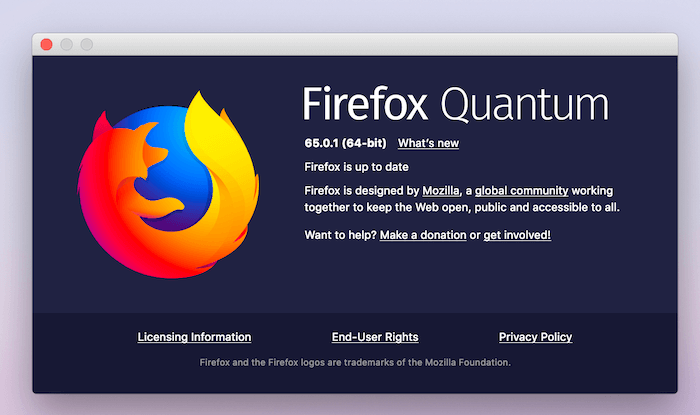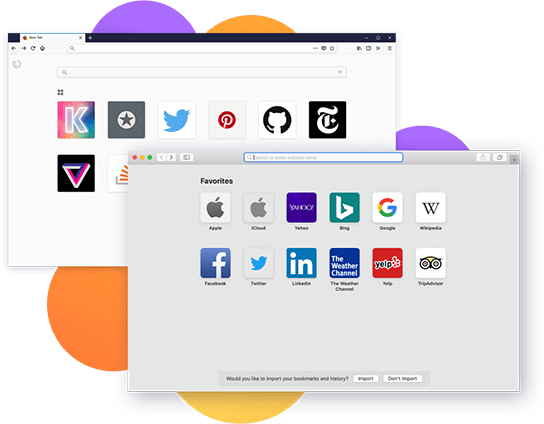

- #Other programs that work like firefox for mac mac os x
- #Other programs that work like firefox for mac drivers
- #Other programs that work like firefox for mac driver
- #Other programs that work like firefox for mac code
- #Other programs that work like firefox for mac windows
Safari version 12 (available in MacOS Mojave) has available support for WebGL 2.0, currently as an "Experimental" feature.
#Other programs that work like firefox for mac mac os x
Safari – Safari 6.0 and newer versions installed on OS X Mountain Lion, Mac OS X Lion and Safari 5.1 on Mac OS X Snow Leopard implemented support for WebGL 1.0, which was disabled by default before Safari 8.0.
#Other programs that work like firefox for mac windows
Since 2013 Firefox also uses DirectX on the Windows platform via ANGLE.
#Other programs that work like firefox for mac drivers
Firefox – WebGL 1.0 has been enabled on all platforms that have a capable graphics card with updated drivers since version 4.0.Since September 2013, Chrome also has a newer Direct3D 11 renderer, which however requires a newer graphics card. It is also possible to force OpenGL as the renderer on Windows.

On Linux and Mac OS X the default renderer is OpenGL however.
#Other programs that work like firefox for mac driver
By default on Windows, Chrome uses the ANGLE (Almost Native Graphics Layer Engine) renderer to translate OpenGL ES to Direct X 9.0c or 11.0, which have better driver support.

More detailed information (like what renderer the browser uses, and what extensions are available) is provided at third-party websites. The official WebGL website offers a simple test page. However its availability is dependent on other factors like the GPU supporting it. WebGL is widely supported by modern browsers. ″ Chrome uses ANGLE for all graphics rendering on Windows, including the accelerated Canvas2D implementation and the Native Client sandbox environment.″ ANGLE currently provides access to OpenGL ES 2.0 and 3.0 to desktop OpenGL, OpenGL ES, Direct3D 9, and Direct3D 11 APIs. It is a default backend for both Google Chrome and Mozilla Firefox on Windows platforms and works by translating WebGL and OpenGL calls to available platform-specific APIs. Implementations Almost Native Graphics Layer Engine Īlmost Native Graphics Layer Engine (ANGLE) is an open source graphic engine which implements WebGL 1.0 (2.0 which closely conforms to ES 3.0) and OpenGL ES 2.0 and 3.0 standards. įirst implementations are in Firefox 51, Chrome 56 and Opera 43. This specification is based on OpenGL ES 3.0. ĭevelopment of the WebGL 2 specification started in 2013 with final in January 2017. These applications included Fusion 360 and AutoCAD 360. In November 2012 Autodesk announced that they ported most of their applications to the cloud running on local WebGL clients. As of March 2012, the chair of the working group is Ken Russell.Įarly applications of WebGL include Zygote Body. Version 1.0 of the WebGL specification was released March 2011. In early 2009, the non-profit technology consortium Khronos Group started the WebGL Working Group, with initial participation from Apple, Google, Mozilla, Opera, and others. By the end of 2007, both Mozilla and Opera had made their own separate implementations. Vukićević first demonstrated a Canvas 3D prototype in 2006. WebGL evolved out of the Canvas 3D experiments started by Vladimir Vukićević at Mozilla.
#Other programs that work like firefox for mac code
This code is executed for each and every vertex sent through the API and for each pixel rasterized to the screen. The WebGL implementation compiles these shader instructions to GPU code. Shaders in WebGL are expressed directly in GLSL and passed to the WebGL API as textual strings. This functionality, if so required, has to be implemented by the end-developer by providing shader code and configuring data bindings in JavaScript. Like OpenGL ES 2.0, WebGL does not have the fixed-function APIs introduced in OpenGL 1.0 and deprecated in OpenGL 3.0. Automatic memory management is provided implicitly by JavaScript. WebGL 2.0 is based on OpenGL ES 3.0 and made guaranteed availability of many optional extensions of WebGL 1.0 and exposes new APIs. It uses the HTML5 canvas element and is accessed using Document Object Model (DOM) interfaces. WebGL 1.0 is based on OpenGL ES 2.0 and provides an API for 3D graphics.


 0 kommentar(er)
0 kommentar(er)
